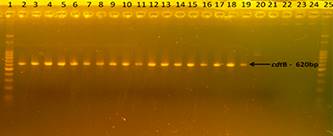Abstract:
Thermophilic members of the Campylobacter genus are recognized as important enteropathogenics for humans and animals. The great variety of ecological habitats, such as water, food and milk, may promote new virulence factors. To detect the encoding genes distending cytolethal toxin (CDT) by PCR and study the hemolytic activity with influence of chelation solutions and ions, 45 Campylobacter jejuni samples from poultry production origin were used to perform the hemolytic research. To check the influence of chelation agents and solution of ions in the hemolytic activity, samples of C. jejuni strains were grown in tryptone soy broth TSB containing chelation agents separately EDTA, acetic acid, CaCl2, MgCl2 and FeCl3 ions solutions in microaerophilic atmosphere and then streaked on 5% sheep blood tryptic soy agar (TSA). To perform the detection of cdtA, cdtB and cdtC genes the technique of Polymerase Chain Reaction (PCR) was used in 119 samples of C. jejuni from poultry production origin. We found 40% of samples showing hemolysis after growing with TSB. Only the acetic acid showed reduction in hemolysis. The prevalent gene profile was cdtABC in 37.8 % of the samples. It was observed that the results showed the presence of C. jejuni strains with virulent potential, due to presence of the CDT toxin genes and the hemolytic activity, which showed in vitro reduced when acetic acid was added.
Index Terms:
PCR; hemolytic activity; ions; chelants; CDT; Campylobacter jejuni.

 Detection of the genes encoding the toxin CDT, and research factors which influence the production of hemolysin in Campylobacter jejuni from poultry products
Detection of the genes encoding the toxin CDT, and research factors which influence the production of hemolysin in Campylobacter jejuni from poultry products Thumbnail
Thumbnail
 Thumbnail
Thumbnail



